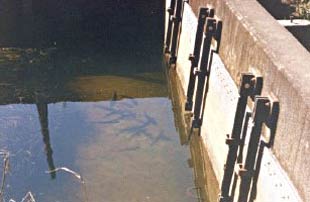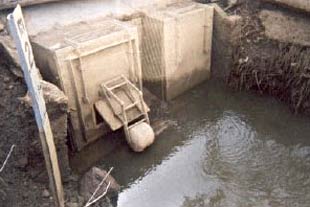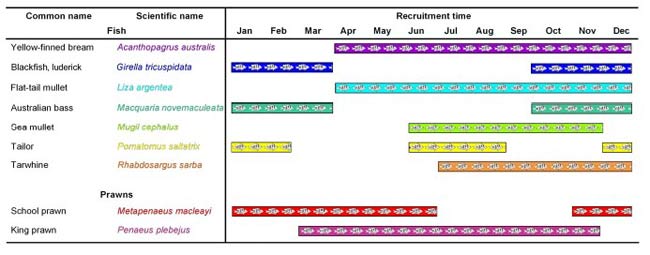
Managing drains and tidal creeks for fish passage
Australia’s coastal floodplains have many kilometres of drains and modified watercourses. Small tidal creeks and channels on the floodplain are vital habitat areas, very important for the life cycles of many fish and prawn species.
The majority of such creeks and channels now have floodgates. In many instances they have also been modified and straightened. While floodgates act as blocks to saline tidal water, they also present physical barriers to juvenile fish and prawns (Figure 1).
What you can do
Controlled opening of floodgates allows fish and prawns to access upstream habitat areas. Opening floodgates can also help improve drain water quality and therefore improve the quality of the fish habitat (See Managing floodgates to improve drain water quality).

Research has shown that opening floodgates improves fish passage. However, these improvements quickly disappear when floodgates are closed for long periods or when the frequency of opening decreases.
As a rule of thumb, it is better to have small, frequent openings (i.e. every day) than large, infrequent openings. This can be readily achieved using automated opening devices, like tidal floodgates (Figure 2).
Things to consider
If you are interested in opening floodgates to improve fish passage, it is important to contact your local Fisheries office. They can provide you with useful information and may be able to direct you to sources of funding for floodgate modifications.
Different species of fish, as well as the different life stages of these species, have different swimming abilities and behaviours that affect their ability to move past open floodgates. Some species prefer to move during the day, others at night; some travel with the current, others against it. To maximise fish passage, floodgate modifications should ideally
- have as large an opening as possible to reduce current flow
- cover as much of the water column as possible
- operate automatically during day and night tidal cycles.


Check with your local Fisheries office for more detailed local times.
Research has also shown that juvenile fish move into all drainage systems, whether they are modified natural creeks or man-made drains. So, opening floodgates at the right time (Table 1), for the right amount of time, will help the fishery by allowing juvenile fish and prawns to access upstream habitat and food.
Improving the water quality of the drainage system is also vital for fish passage. Fish and other estuarine species depend on good quality water to survive. Poor quality water can cause direct fish kills or make fish more prone to disease. Some species are very sensitive at detecting acidity due to acid sulfate soil run-off and tend to avoid such water if possible. Their avoidance of acid water may reduce the proportion of habitat they can use.
Restoring the natural vegetation in and alongside tidal creeks is also important. Species like mangroves provide very valuable habitat for juvenile fish. Shade provided by native trees also reduces light and moderates water temperatures, which helps improve water quality.
Further information
For further information, advice and assistance on floodgate and drain management contact NSW DPI.
Citation: Johnston S, Bruce A, Kroon F (2004) Floodgate and drain management on coastal floodplains leaflet 3: Managing drains and tidal creeks for fish passage. (NSW Agriculture: Wollongbar)

